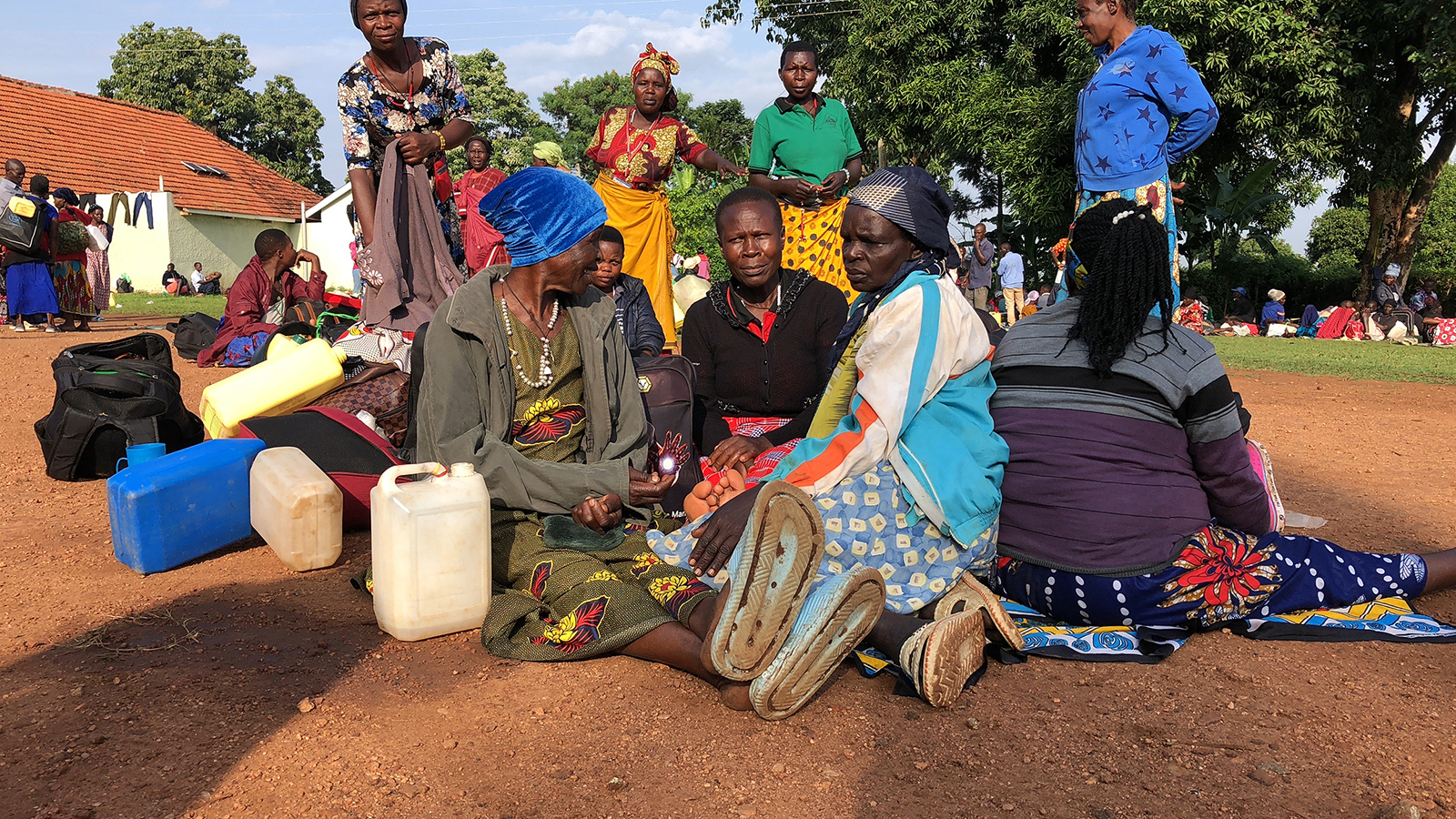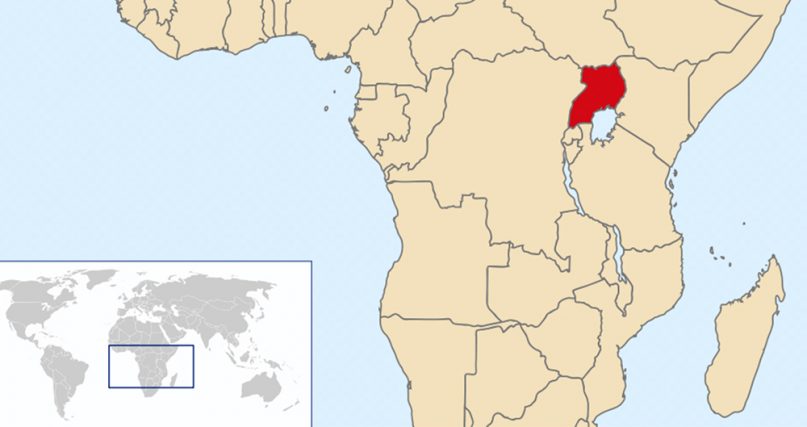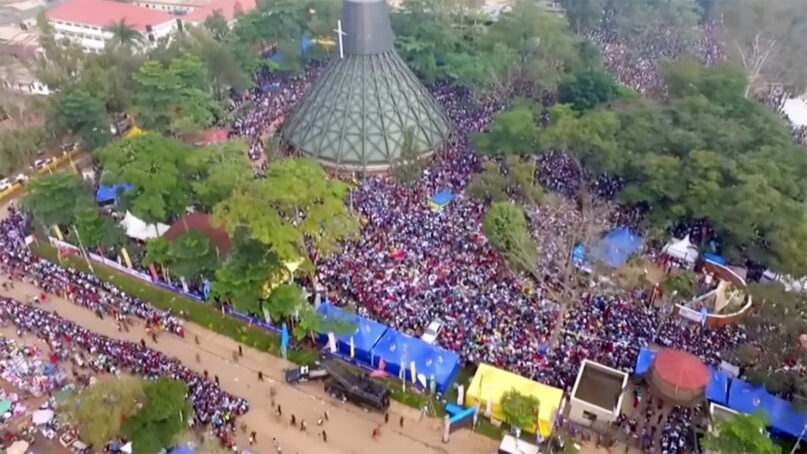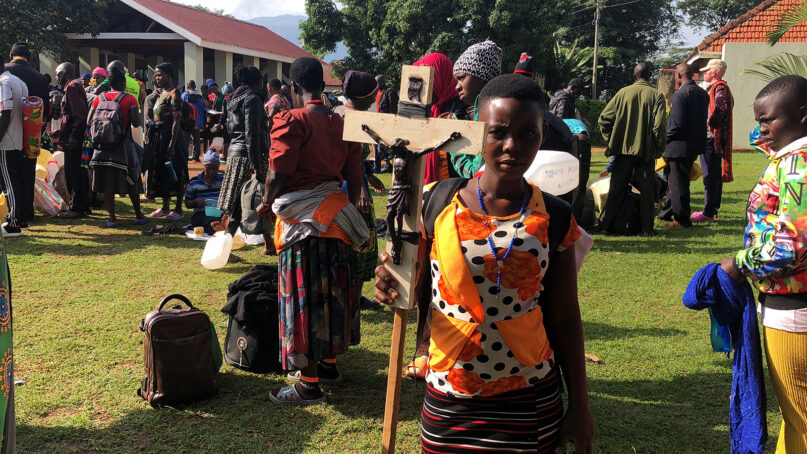
NAMUGONGO, Uganda (RNS) — Beneath the equatorial sun and a sky streaked with clouds, thousands of pilgrims move slowly toward Namugongo. Their bare feet blistered, lips murmuring prayers and hands clutching rosaries, many walk hundreds of miles toward the sacred site for Uganda’s Martyrs Day, one of the largest annual religious events in Africa.
This year, about 1 million people are expected to gather on Tuesday (June 3) to honor the 45 Christian converts — 22 Catholics and 23 Anglicans — executed between 1885 and 1887 by the orders of Buganda King Mwanga II for refusing to renounce their faith.
Pilgrims — many dressed in red — come from across Uganda and neighboring countries, including Kenya, Tanzania, Rwanda, South Sudan and Congo. Some walk for weeks, covering hundreds of kilometers to reach the place where the martyrs were burned or beheaded for their beliefs. Uganda’s tourism officials have said Martyrs’ Day now fuels a major religious tourism sector, generating millions annually through transportation, hospitality and trade.
“Every sore on my feet is part of my prayer,” said Brenda Wesonga, a pilgrim from Bungoma, Kenya, who walked for three weeks, covering more than 300 kilometers, or 186 miles. “We’re praying for peace, for justice in our countries and for strength to carry on.”
Joining this year are dozens of leaders from different Christian denominations, making the journey not only an expression of personal devotion but a public show of unity and spiritual leadership in a region challenged by political instability, poverty and insecurity.

Uganda, in red, located in eastern Africa. (Image courtesy of Wikimedia/Creative Commons)
Pastor John Wanyama of Revival Pentecostal Church in Busia, a border town between Kenya and Uganda, traveled with 500 fellow pilgrims.
“Namugongo reminds us of the cost of true faith,” he said. “In these divided times, coming together like this is a powerful message.”
The pilgrimage is a symbol of ecumenism. Catholic and Anglican shrines stand side by side in Namugongo, commemorating the martyrs who were killed together despite belonging to different Christian traditions.
“Our styles of worship may vary, but our shared faith and the blood of the martyrs connect us,” said catechist Peter Okumu from northern Uganda, a regular pilgrim for nearly a decade.
The Uganda martyrs were canonized by Pope Paul VI in 1964, and their story continues to resonate across Africa. In 1993, Pope John Paul II visited Namugongo. And in 2015, Pope Francis celebrated Mass at the shrine during his visit to Uganda.
Today, a basilica honoring the martyrs dominates the landscape, blending African architecture with Catholic tradition. Its gleaming copper roof marks the spot where St. Charles Lwanga, the group’s leader, was burned alive on June 3, 1886.

Pilgrims surround the Basilica of the Uganda Martyrs in Namugongo, Uganda, during a previous annual celebration. (Video screen grab)
“They remind us that faith sometimes demands courage, especially in the face of persecution,” Okumu said. “The martyrs refused immoral orders and chose death over disobedience to God. They challenge us to stay true, even when it’s hard.”
Thousands from Uganda’s northern regions began their pilgrimage in mid-May, walking more than 300 kilometers. Among them are elderly women, children and clergy.
“We walked with intention,” said Grace Akello, who traveled with her children. “At night, people welcomed us into churches or schools. They shared food, water, even medicine for our wounds. This walk humbles you.”
Bishop Godfrey Loum of the Anglican Diocese of Northern Uganda emphasized that the pilgrimage is not just physical, but deeply spiritual. He compared it to prayer and fasting — a sacred space for reflection, healing and surrender.
“A pilgrimage is more than walking — it is about entering God’s presence and opening your heart,” Loum said.
Many pilgrims are students and young professionals searching for purpose in a region where religion remains a core part of their cultural identity.

A young woman displays a crucifix during her pilgrimage to the Namugongo Shrine, near Kampala, Uganda. (Photo by Tonny Onyulo)
“Young people today face distractions,” said Geofrey Etiang, 22, from Mbale in eastern Uganda, adding that several of the martyrs were teenagers. “But the story of the martyrs shows us that even teenagers can stand strong for what they believe,” demonstrating young people take leadership in the church.
To ensure safety, authorities have deployed security personnel, first-aid teams and water stations on the route. Some faith leaders, however, are urging for better medical care along the pilgrimage path.
Officials are also warning pilgrims against drinking water from the man-made lake and springs at the shrine. While many believe the water holds healing power, health professionals say it may be contaminated and pose risks such as diarrhea or cholera. Church and government officials are working to treat the water but recommend boiling it before use.
“Spiritual faith is important, but we must also protect our bodies,” said Bishop Alfred Olwa of the Lango Diocese in Uganda.
Uganda President Yoweri Museveni, who often attends the event, has in the past urged Ugandans to live as peace builders, drawing strength from the martyrs’ sacrifice. This year, some religious leaders are urging deeper reflection, challenging believers to address issues facing their communities such as corruption, youth unemployment and violence against women.
“The martyrs stood up to injustice,” Wanyama said. “Our faith should inspire action — to protect the vulnerable and demand accountability.”
As June 3 approaches, many pilgrims will sleep outdoors beneath tarpaulins and stars, holding onto the belief that their journey has meaning spiritually and socially. At night, choirs sing hymns in Swahili, Luganda and Latin.
For many pilgrims of East Africa, the Uganda Martyrs represent not just figures of the past, but a call to live boldly, act justly and walk faithfully, step by step.
“Today’s martyrs suffer differently, through poverty, addiction or past mistakes,” said David Okuku, a former gang member who walked from northern Uganda. “We may not die by fire, but we still carry a cross. And we still believe.”
